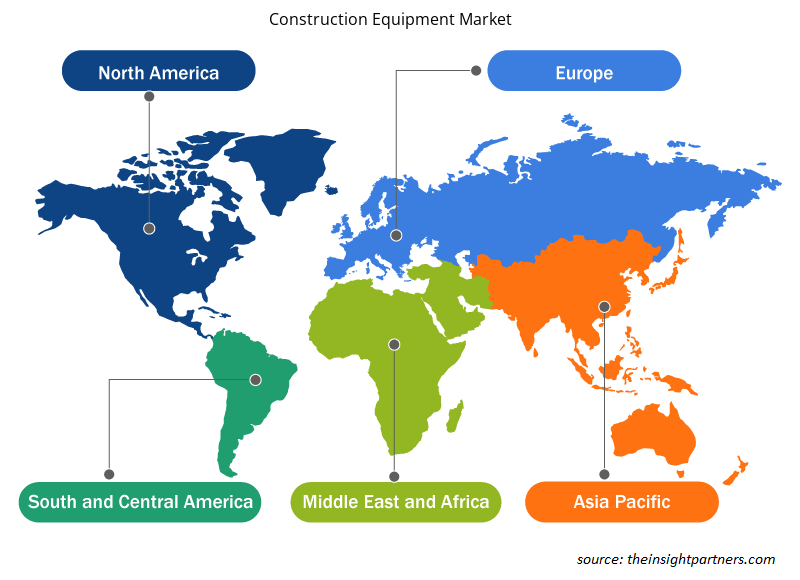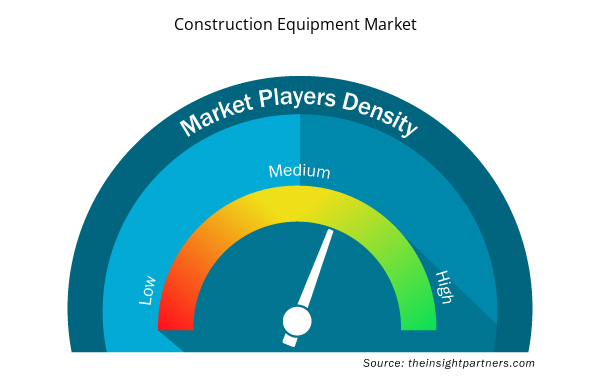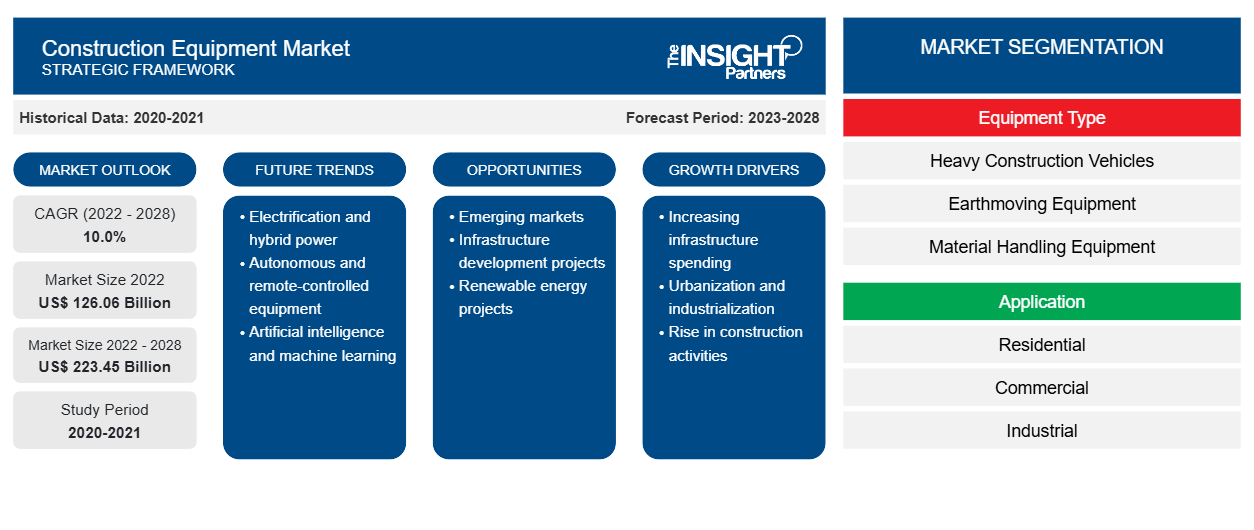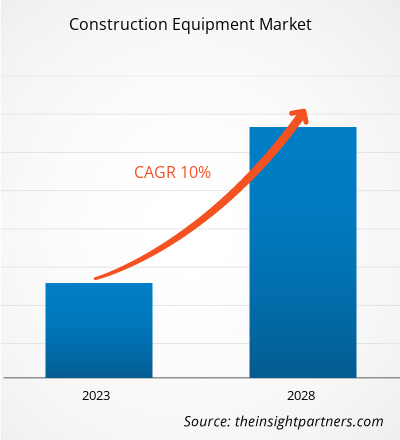Si prevede che il mercato delle attrezzature per l'edilizia crescerà da 126.062,8 milioni di dollari nel 2022 a 223.451,1 milioni di dollari entro il 2028; si stima che crescerà a un CAGR del 10,0% dal 2022 al 2028.
I veicoli pesanti sviluppati specificamente per svolgere lavori di costruzione, più comunemente operazioni di movimento terra, sono denominati attrezzature da costruzione. L'uso appropriato di attrezzature idonee contribuisce all'economia, alla qualità, alla sicurezza, alla velocità e alla tempestività del progetto. Non è sempre auspicabile o fattibile che l'appaltatore possieda tutte le attrezzature da costruzione necessarie per il progetto. Scavare, scavare terra, spostarla su grandi distanze, posizionarla, compattarla, livellarla, spianarla, livellarla e trasportarla sono tra i principali processi coinvolti nella costruzione di qualsiasi progetto di costruzione.
Vari lavori di scavo, come lo scavo e lo spostamento del terreno, vengono eseguiti con attrezzature per movimento terra. Le attrezzature per movimento terra sono disponibili in varie forme e dimensioni. Sono utilizzate principalmente per scopi di riparazione, costruzione, sollevamento, agricoltura e demolizione. Gli escavatori sono macchine per movimento terra con benne, bracci, cabine rotanti e cingoli mobili. Un escavatore a cucchiaia rovescia, noto anche come attore posteriore o escavatore posteriore, è un tipo di attrezzatura per scavo con una benna da scavo attaccata all'estremità di un braccio articolato in due parti. La pala caricatrice è una macchina edile che sposta o carica materiali, tra cui asfalto, rifiuti di demolizione, terra, neve, mangimi, ghiaia, tronchi, minerali grezzi, materiale riciclato, roccia, sabbia e trucioli di legno, dentro o sopra un altro tipo di macchinario.
Personalizza questo report in base alle tue esigenze
Riceverai la personalizzazione gratuita di qualsiasi report, comprese parti di questo report, o analisi a livello nazionale, pacchetto dati Excel, oltre a usufruire di grandi offerte e sconti per start-up e università
- Scopri le principali tendenze di mercato in questo rapporto.Questo campione GRATUITO includerà analisi di dati che spaziano dalle tendenze di mercato alle stime e alle previsioni.
Gli stakeholder chiave nel mercato delle attrezzature edili sono le materie prime per le attrezzature edili, i produttori di attrezzature edili che operano sul lato dell'offerta e gli utenti finali di attrezzature edili che operano sul lato della domanda. Negli ultimi anni, la domanda di attrezzature edili, in particolare nell'edilizia residenziale e commerciale, è aumentata, il che dovrebbe guidare la crescita del mercato delle attrezzature edili nei prossimi cinque anni. Caterpillar, John Deere, Komatsu, Volvo e Liebherr sono tra i principali fornitori di attrezzature edili. Oltre a questi importanti attori dell'ecosistema, ci sono diversi altri stakeholder periferici che svolgono un ruolo cruciale nel consentire i progressi nelle tecnologie e l'adozione di questi prodotti in diversi settori.
Impatto della pandemia di COVID-19 sul mercato delle attrezzature per l'edilizia
Nel 2020, la pandemia di COVID-19 ha ostacolato le attività di costruzione. Di conseguenza, le vendite di attrezzature per l'edilizia sono diminuite in tutto il mondo. Gli investimenti infrastrutturali; l'edilizia residenziale, commerciale e industriale; la costruzione sotterranea e di pozzi; e la spesa istituzionale influenzano i produttori di attrezzature per l'edilizia. Stati Uniti, Regno Unito, Cina e India sono tra i paesi che sono stati colpiti in modo sproporzionato. Secondo l'International Construction Group, la consegna di oltre un quarto di tutti i progetti (22,7%) è stata ritardata di oltre 250 giorni e più di un decimo di tutti i progetti (13,4%) è stato ritardato di oltre un anno nel 2020. Tuttavia, i progetti di ospedali e altre strutture mediche, laboratori e infrastrutture di spedizione e logistica sono in quantità limitata. Inoltre, diverse nazioni hanno iniziato a riprendere gradualmente le attività in vari settori, tra cui l'industria edile. India e Cina hanno avviato progetti di costruzione industriale e commerciale. Ad aprile 2021, la produzione industriale è aumentata per la prima volta da gennaio 2021, poiché i paesi hanno iniziato a implementare nuovi progetti. Di conseguenza, la domanda di escavatori, terne, compattatori, bulldozer e altre attrezzature edili è aumentata.
Market Insight
Aumento degli investimenti infrastrutturali dopo la pandemia di COVID-19
Le attività economiche in tutto il mondo sono state notevolmente soffocate dalla pandemia di COVID-19. Ci sono stati enormi investimenti nelle infrastrutture nel 2020-21, che hanno dato slancio alla crescita del settore delle infrastrutture. Gli investimenti infrastrutturali nella produzione di elettricità, nella costruzione di autostrade nazionali, nelle ferrovie e nella spedizione di merci spingono la domanda di attrezzature per l'edilizia. Nelle economie emergenti, alcuni settori infrastrutturali fondamentali, tra cui carbone, petrolio greggio, acciaio e cemento, hanno mostrato l'indice di crescita nel 2021. Questi fattori hanno avuto un impatto positivo sulla crescita del mercato delle attrezzature per l'edilizia. Gli investimenti infrastrutturali hanno un impatto a lungo termine sullo sviluppo del prodotto, che può aumentare il PIL a lungo termine, sebbene la portata di questi effetti sia sconosciuta. La maggior parte dei paesi, in particolare in Medio Oriente, ha istituito un forum economico quadrilaterale per concentrarsi sui progetti di sviluppo infrastrutturale nella regione. Per facilitare la comunicazione tra dipendenti e con i consumatori, le aziende utilizzano soluzioni e canali digitali. Anche i governi e gli istituti scolastici hanno fatto lo stesso.
Informazioni sul segmento di tipo di apparecchiatura
Un gran numero di attrezzature edili viene utilizzato più che mai, a causa del crescente numero di progetti commerciali, residenziali e industriali che richiedono utensili e macchinari pesanti per portare a termine il lavoro. Nei grandi progetti, le attrezzature edili pesanti vengono impiegate per vari compiti. La scelta dei tipi di attrezzature pesanti si basa sulla portata e sul costo del progetto. Questi fattori facilitano e velocizzano il processo di costruzione. Gli escavatori sono un pezzo di attrezzatura essenziale e frequentemente utilizzato nel settore edile.
Approfondimenti sui segmenti applicativi
In base all'applicazione, il mercato delle attrezzature edili è suddiviso in residenziale, commerciale e industriale. Uno strumento di costruzione noto come impianto di miscelazione dell'asfalto viene utilizzato per produrre pietrisco rivestito e altri tipi di calcestruzzo asfaltico da utilizzare nei progetti di costruzione stradale. I rulli stradali sono essenzialmente macchine di ingegneria di tipo compattatore che spingono verso il basso terra, ghiaia, calcestruzzo o asfalto durante la costruzione di strade e fondamenta. Per l'installazione di pali prefabbricati per grattacieli e altri enormi complessi industriali che necessitano di fondamenta profonde, viene utilizzata una macchina perforatrice per pali per creare fori verticali in un cantiere, con conseguente crescita del mercato delle attrezzature edili.
Gli operatori del mercato delle attrezzature edili si concentrano su nuove innovazioni e sviluppi di prodotto integrando tecnologie e funzionalità avanzate per competere con i concorrenti. A giugno 2022, Caterpillar Inc. ha annunciato che la sua sede centrale mondiale verrà trasferita da Deerfield, Illinois, all'attuale stabilimento dell'azienda a Irving, Texas. L'azienda inizierà a trasferire la sua sede centrale a Irving nel 2022.
In base al tipo di attrezzatura, il mercato delle attrezzature edili è segmentato in veicoli pesanti per l'edilizia, attrezzature per movimento terra, attrezzature per la movimentazione dei materiali e altri. Il mercato, in base all'applicazione, è segmentato in residenziale, commerciale e industriale. In base alla regione, il mercato globale delle attrezzature edili è segmentato in Nord America, Europa, Asia Pacifico, Medio Oriente e Africa e Sud America.
Approfondimenti regionali sul mercato delle attrezzature per l'edilizia
Le tendenze regionali e i fattori che influenzano il mercato delle attrezzature per l'edilizia durante il periodo di previsione sono stati ampiamente spiegati dagli analisti di Insight Partners. Questa sezione discute anche i segmenti e la geografia del mercato delle attrezzature per l'edilizia in Nord America, Europa, Asia Pacifico, Medio Oriente e Africa e America meridionale e centrale.

- Ottieni i dati specifici regionali per il mercato delle attrezzature da costruzione
Ambito del rapporto sul mercato delle attrezzature per l'edilizia
| Attributo del report | Dettagli |
|---|---|
| Dimensioni del mercato nel 2022 | 126,06 miliardi di dollari USA |
| Dimensioni del mercato entro il 2028 | 223,45 miliardi di dollari USA |
| CAGR globale (2022 - 2028) | 10,0% |
| Dati storici | 2020-2021 |
| Periodo di previsione | 2023-2028 |
| Segmenti coperti | Per tipo di apparecchiatura
|
| Regioni e Paesi coperti | America del Nord
|
| Leader di mercato e profili aziendali chiave |
|
Densità degli operatori del mercato delle attrezzature per l'edilizia: comprendere il suo impatto sulle dinamiche aziendali
Il mercato delle attrezzature per l'edilizia sta crescendo rapidamente, spinto dalla crescente domanda degli utenti finali dovuta a fattori quali l'evoluzione delle preferenze dei consumatori, i progressi tecnologici e una maggiore consapevolezza dei vantaggi del prodotto. Con l'aumento della domanda, le aziende stanno ampliando le loro offerte, innovando per soddisfare le esigenze dei consumatori e capitalizzando sulle tendenze emergenti, il che alimenta ulteriormente la crescita del mercato.
La densità degli operatori di mercato si riferisce alla distribuzione di aziende o società che operano in un particolare mercato o settore. Indica quanti concorrenti (operatori di mercato) sono presenti in un dato spazio di mercato in relazione alle sue dimensioni o al valore di mercato totale.
Le principali aziende che operano nel mercato delle attrezzature per l'edilizia sono:
- Caterpillar Inc
- CNH Industriale NV
- Komatsu Ltd
- Liebherr
- Società Terex
Disclaimer : le aziende elencate sopra non sono classificate secondo un ordine particolare.

- Ottieni una panoramica dei principali attori del mercato delle attrezzature per l'edilizia
mercato delle attrezzature per l'edilizia – Profili aziendali
- Caterpillar Inc.
- CNH Industriale NV
- Hitachi Construction Machinery Co., Ltd
- Escavatori JC Bamford Ltd.
- Deere & Società
- Società per azioni Komatsu Ltd.
- Liebherr-International Deutschland GmbH
- Società Terex
- Volvo CE
- Zoomlion Heavy Industry Science and Technology Co., Ltd.
- Analisi storica (2 anni), anno base, previsione (7 anni) con CAGR
- Analisi PEST e SWOT
- Valore/volume delle dimensioni del mercato - Globale, regionale, nazionale
- Industria e panorama competitivo
- Set di dati Excel


- Equipment Rental Software Market
- Hydrogen Storage Alloys Market
- Photo Printing Market
- Social Employee Recognition System Market
- Non-Emergency Medical Transportation Market
- Enteral Nutrition Market
- HVAC Sensors Market
- Collagen Peptides Market
- Enzymatic DNA Synthesis Market
- Employment Screening Services Market

Report Coverage
Revenue forecast, Company Analysis, Industry landscape, Growth factors, and Trends

Segment Covered
This text is related
to segments covered.

Regional Scope
North America, Europe, Asia Pacific, Middle East & Africa, South & Central America

Country Scope
This text is related
to country scope.
Domande frequenti
Asia-Pacific dominated the Construction Equipment Market in 2021 with a share of 36.0%; it would continue to dominate the market during the forecast period and account for 38.4% share by 2028
The global construction equipment market size is projected to reach US$ 223451.09 million by 2028.
The material handling equipment segment led the construction equipment market in 2021.
APAC is the fastest-growing regional market in the global construction equipment market in 2021.
The key players holding the major market share of the construction equipment market are Caterpillar, Komatsu, VOLVO Construction Equipment, John Deere and Liebherr.
The Future trends impacting the construction equipment market are -- Growing Demand for the Artificial Intelligence
The global construction equipment market was valued at US$ 120661.95 million in 2021
The driving factors impacting the construction equipment market are
I. Increasing Infrastructure Investments Post COVID-19 Pandemic
Growing Focus on Public-Private Partnerships (PPP)
Trends and growth analysis reports related to Manufacturing and Construction : READ MORE..
The List of Companies -Construction Equipment Market
- Caterpillar Inc
- CNH Industrial N.V.
- Komatsu Ltd
- Liebherr
- Terex Corporation
- Zoomlion Heavy Industry Science&Technology Co., Ltd.
- J C Bamford Excavators Ltd. (JCB)
- Deere & Company
- AB Volvo
- Hitachi Construction Machinery Co., Ltd.
The Insight Partners performs research in 4 major stages: Data Collection & Secondary Research, Primary Research, Data Analysis and Data Triangulation & Final Review.
- Data Collection and Secondary Research:
As a market research and consulting firm operating from a decade, we have published and advised several client across the globe. First step for any study will start with an assessment of currently available data and insights from existing reports. Further, historical and current market information is collected from Investor Presentations, Annual Reports, SEC Filings, etc., and other information related to company’s performance and market positioning are gathered from Paid Databases (Factiva, Hoovers, and Reuters) and various other publications available in public domain.
Several associations trade associates, technical forums, institutes, societies and organization are accessed to gain technical as well as market related insights through their publications such as research papers, blogs and press releases related to the studies are referred to get cues about the market. Further, white papers, journals, magazines, and other news articles published in last 3 years are scrutinized and analyzed to understand the current market trends.
- Primary Research:
The primarily interview analysis comprise of data obtained from industry participants interview and answers to survey questions gathered by in-house primary team.
For primary research, interviews are conducted with industry experts/CEOs/Marketing Managers/VPs/Subject Matter Experts from both demand and supply side to get a 360-degree view of the market. The primary team conducts several interviews based on the complexity of the markets to understand the various market trends and dynamics which makes research more credible and precise.
A typical research interview fulfils the following functions:
- Provides first-hand information on the market size, market trends, growth trends, competitive landscape, and outlook
- Validates and strengthens in-house secondary research findings
- Develops the analysis team’s expertise and market understanding
Primary research involves email interactions and telephone interviews for each market, category, segment, and sub-segment across geographies. The participants who typically take part in such a process include, but are not limited to:
- Industry participants: VPs, business development managers, market intelligence managers and national sales managers
- Outside experts: Valuation experts, research analysts and key opinion leaders specializing in the electronics and semiconductor industry.
Below is the breakup of our primary respondents by company, designation, and region:

Once we receive the confirmation from primary research sources or primary respondents, we finalize the base year market estimation and forecast the data as per the macroeconomic and microeconomic factors assessed during data collection.
- Data Analysis:
Once data is validated through both secondary as well as primary respondents, we finalize the market estimations by hypothesis formulation and factor analysis at regional and country level.
- Macro-Economic Factor Analysis:
We analyse macroeconomic indicators such the gross domestic product (GDP), increase in the demand for goods and services across industries, technological advancement, regional economic growth, governmental policies, the influence of COVID-19, PEST analysis, and other aspects. This analysis aids in setting benchmarks for various nations/regions and approximating market splits. Additionally, the general trend of the aforementioned components aid in determining the market's development possibilities.
- Country Level Data:
Various factors that are especially aligned to the country are taken into account to determine the market size for a certain area and country, including the presence of vendors, such as headquarters and offices, the country's GDP, demand patterns, and industry growth. To comprehend the market dynamics for the nation, a number of growth variables, inhibitors, application areas, and current market trends are researched. The aforementioned elements aid in determining the country's overall market's growth potential.
- Company Profile:
The “Table of Contents” is formulated by listing and analyzing more than 25 - 30 companies operating in the market ecosystem across geographies. However, we profile only 10 companies as a standard practice in our syndicate reports. These 10 companies comprise leading, emerging, and regional players. Nonetheless, our analysis is not restricted to the 10 listed companies, we also analyze other companies present in the market to develop a holistic view and understand the prevailing trends. The “Company Profiles” section in the report covers key facts, business description, products & services, financial information, SWOT analysis, and key developments. The financial information presented is extracted from the annual reports and official documents of the publicly listed companies. Upon collecting the information for the sections of respective companies, we verify them via various primary sources and then compile the data in respective company profiles. The company level information helps us in deriving the base number as well as in forecasting the market size.
- Developing Base Number:
Aggregation of sales statistics (2020-2022) and macro-economic factor, and other secondary and primary research insights are utilized to arrive at base number and related market shares for 2022. The data gaps are identified in this step and relevant market data is analyzed, collected from paid primary interviews or databases. On finalizing the base year market size, forecasts are developed on the basis of macro-economic, industry and market growth factors and company level analysis.
- Data Triangulation and Final Review:
The market findings and base year market size calculations are validated from supply as well as demand side. Demand side validations are based on macro-economic factor analysis and benchmarks for respective regions and countries. In case of supply side validations, revenues of major companies are estimated (in case not available) based on industry benchmark, approximate number of employees, product portfolio, and primary interviews revenues are gathered. Further revenue from target product/service segment is assessed to avoid overshooting of market statistics. In case of heavy deviations between supply and demand side values, all thes steps are repeated to achieve synchronization.
We follow an iterative model, wherein we share our research findings with Subject Matter Experts (SME’s) and Key Opinion Leaders (KOLs) until consensus view of the market is not formulated – this model negates any drastic deviation in the opinions of experts. Only validated and universally acceptable research findings are quoted in our reports.
We have important check points that we use to validate our research findings – which we call – data triangulation, where we validate the information, we generate from secondary sources with primary interviews and then we re-validate with our internal data bases and Subject matter experts. This comprehensive model enables us to deliver high quality, reliable data in shortest possible time.


 Ottieni un campione gratuito per questo repot
Ottieni un campione gratuito per questo repot